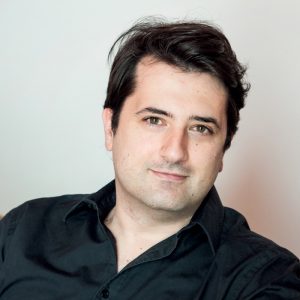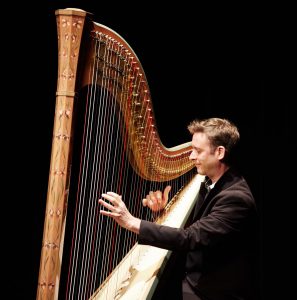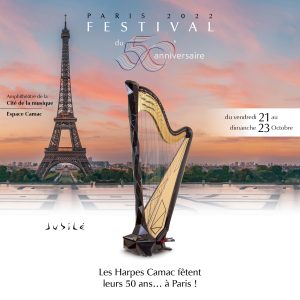Camac Blog
“Péripéties et Conclusion” by Bruno Mantovani
Latest
October 17, 2022
At the Camac Festival in Paris this week, we are looking forward to the world premiere of Bruno Mantovani‘s Péripéties et Conclusion. The work is written for the same instrumentation as Ravel’s Septet, and will be premiered by Sylvain Blassel. Read more in the following interview with Sylvain!
Sylvain, soon you’re going to premier Bruno Mantovani’s Péripéties et Conclusion. How are you approaching the music?
First of all, Bruno Mantovani really understands the harp. In 2007 he wrote a piece for solo harp that all harpists know today: Tocar, for Constance Luzzati. A decade later, he composed Danse libre for harp and chamber orchestra, dedicated to Isabelle Moretti and which I consider to be a real masterpiece. His Danse libre relates to Debussy’s Danses, and the Péripéties et Conclusion are connected to Ravel’s Introduction and Allegro. It was harp makers who commissioned the Debussy Dances (Pleyel) and the Ravel septet (Erard), and Péripéties et Conclusion have been commissioned by Jakez François for Camac Harps. In this way, Péripéties et Conclusion are part of the deepest part of our harp repertoire, and it is a great privilege and responsibility for me to premier them.
The first piece by Bruno Mantovani that I ever played was Streets, written for the Ensemble Intercontemporain and Pierre Boulez (2006). Streets is a key work in Bruno’s oeuvre, I think it was the starting point for a lot of things in his language. I find Péripéties et Conclusion has the same approach to the harp, updated. Fifteen years on, it is very exciting for me to discover a completely new work in a universe I already know well.
What appeals to you most about this score?
Without doubt, the harmonic thinking! At least, when reading the score, because at the moment we have not yet started rehearsals. This very sensual, colourful harmony can be found in most of his works, a bit like a signature. If you listen for example to Finale, or D’un jardin féérique for piano and orchestra, you will be immediately seduced by the harmonic environment. As is often the case in Mantovani’s music, you have a chord, held for a long time, and maintained “from within” with accents, tremolos and trills that energize each sound. We sometimes see the same thing in Boulez’s music, since Eclat. Then, all the notes of the chord transform themselves one by one, fading away or being added. This makes the harmonic evolution enormously smooth, like a kind of harmonic legato. Or in contrast, like at the end of Péripéties et Conclusion for example, all the notes of a chord are repeated in rhythmically but at different speeds. They disappear one after the other until only one is left, like a metronome. Ligeti also did this, but Bruno Mantovani’s writing is different. His harmonic thinking goes beyond chordal successions, sequences or resolutions. As with Grisey, he gives us the pleasure of appreciating all the flavours and textures of this or that chord, sometimes for a very long time!
Beyond these flavours, I also think Bruno’s approach to harmony underpins his entire compositional language. It generates his rhythmic developments, his orchestration, his structure and so on. At least, that’s how I feel about it.
Is it a virtuoso piece?
That depends on what you mean by virtuosity. Certainly, as always with Bruno Mantovani’s music, it is a very brilliant, spectacular work that require top-notch players. Quite physical too, with long, uninterrupted tremolos in the harp part. Those can be a bit tiring, but that’s our business. The instrumentation is virtuoso: Mantovani gives this small chamber ensemble a variety of timbres worthy of a much larger ensemble. But I would say that the virtuosity of Péripéties et Conclusion lies more in its writing than in the technique it demands of the musician: Bruno Mantovani “transcends” the instruments for which he writes. He transforms this handful of musicians into a veritable miniature orchestra, and he goes beyond what one expects with the harp.
The entire harp part is based on two idiomatic aspects, which remind me of a reduction for harp of a piece for two two diametrically opposed instruments…which are very distant from the harp! On the one hand, there is highly linear writing, with very long tremolo lines and repeated figures. These totally abolish the idea of a resonant instrument, in favour of an instrument with a continuous sound, almost as if the harp were a wind instrument doing circular breathing. And then there are blocks of very short, frenetic cadential writing, much closer to the writing for the vivace and furtive clarinet that one often hears in his orchestral solos.
Transforming the harp into this sort of new, double instrument…yes, you could also call that a kind of virtuosity.
Do you find this duality in the relationship between the harp and the six musicians?
Absolutely. It’s the same notion of duality as in Boulez’s music: duality between instruments with resonant and continuous sounds, duality of points and blocks, duality of staccato and legato, duality of marked time and smooth time… we’re not talking about simple black/white juxtapositions, but duality where two diametrically opposed parameters coexist and become a new, double element, instead of staying two distinct elements. You find this in almost all of Bruno Mantovani’s pieces. For example, the first ensemble section of Péripéties begins as simple, ornamental doubling of the harp part, and then gradually evolves into a real orchestral treatment. Throughout the piece, the six instruments sometimes intervene as amplification, and sometimes as a shadow, echo or memory of the solo part, as if they were the ‘double’ of the main harp part. The Péripéties are of the concertante genre, but not in the old-fashioned sense!
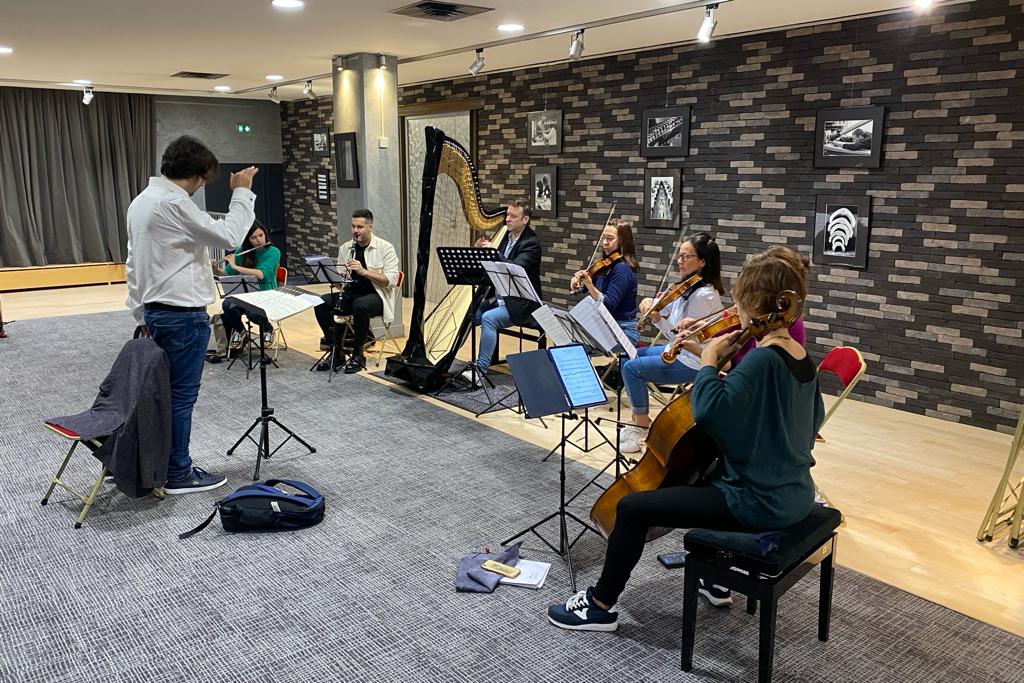
Rehearsing under the baton of the composer at the Espace Camac. Left-right: Mathilde Caldérini (flute), Amaury Viduvier (clarinet), Sylvain Blassel, Rachel Givelet and Aurore Doise (violins), Marion Duchesne (viola), Pauline Bartissol (cello).
You mentioned Boulez and Ligeti. Do you see a link between their music and Mantovani’s? Is there any similarity in their harp writing?
I have the impression that Bruno Mantovani was very much influenced by certain aspects of Boulez’s music, and in many of his pieces one can guess a certain fascination (which I share!) for Repons and sur-Incises. There are clear references to Dérive in his Second Chamber Concerto, for example. But Bruno is no follower: his poetic universe is completely personal and singular, and basically has little to do with Boulez’s. With Ligeti, one could possibly make a quick comparison between Péripéties and the metronomes in Kammerkonzert, and also the rhythmic ostinato evolutions of Continuum. But that’s it. Those pieces were written about fifty years ago, and these are radically different aesthetics and compositional techniques.
Bruno Mantovani’s relationship with time, orchestration and phrasing have nothing to do with anyone. I don’t see any connection between his orchestration and that of Boulez’s Notations or Pli selon Pli. He knows his Boulez as Bach knew his Buxtehude, or Beethoven his Haydn. You can see a certain genealogy there, of course, but composers are not executors of somebody else’s estate. Bruno Mantovani knows Boulez and Ravel inside out, yes, but he writes Mantovani, that’s all. So the traces I find of other works in Péripéties et Conclusion are most of Bruno’s own!
Their harp writing is also very different. Ligeti didn’t write much for harp, only five or six orchestral pieces. Boulez rarely used it. Bruno Mantovani’s harp is very different: often as a soloist, even within the orchestra. Even in Boulez’s works where the harp is prominent (Repons, SurIncises, Dérive 2), I don’t see too many similarities. Boulez thinks of the harp primarily as a keyboard, whereas Mantovani’s harp is much closer to a monodic instrument – at least in Péripéties.
What about Tocar?
Look, Tocar was written more than fifteen years ago. Yes, there are similarities, but the musical language has evolved. Personally, I have always thought of Tocar as a score for ‘principal harp without orchestra’. That is to say, I can easily imagine an instrumental complement to Tocar, whether in the form of a simple resonant support, or indeed an imaginary orchestra. All solo works by Bruno Mantovani that I know tend to be relatively compact, and Tocar has always seemed to me to be searching for its double…perhaps because its orchestral dimension is already so strong that it sounds almost like an orchestral reduction. And I think Péripéties et Conclusion, even if the aesthetics and dynamics of the piece are different, finally offer this double that Tocar has been looking for!
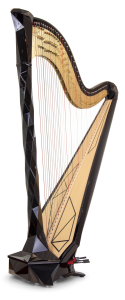 How would you describe the harp writing in Péripéties et Conclusion? Are there any particular playing modes or new effects?
How would you describe the harp writing in Péripéties et Conclusion? Are there any particular playing modes or new effects?
Not at all. No special modes, no pedal zings, no knocking on the soundboard, not even pdlt. The writing is quite classical, with a few harmonics and glissandi. I have the impression Bruno Mantovani writes for the harp exactly as he does for all other instruments: with an in-depth knowledge of it, taking into account its heritage and its expressive and technical potential. It is the same for the other six instruments: a little ponticello and sul tasto, some quarter-tone seasoning from time to time…just to enhance the taste, nothing more.
In fact, I find that Bruno Mantovani’s relationship with his instruments reveals a lot about his musical universe. Strictly speaking, you would not call him “avant-garde”, just as Bach, Mendelssohn, Fauré and even Dutilleux weren’t either. He is not like Berlioz or Stockhausen in this sense. His music keeps a link with the recent past rather than creating rupture or revolution, but he is also in no way nostalgic. As with his approach to instruments, he perfectly assumes his heritage. But above all, he values it and updates it.

